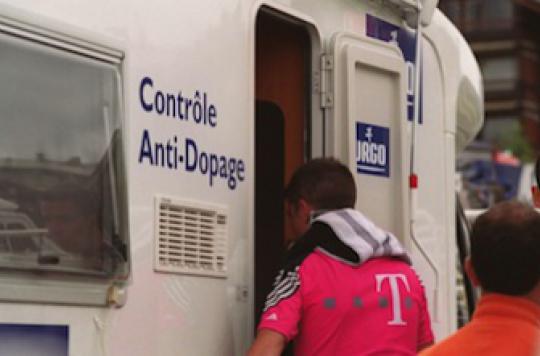While the World Anti-Doping Code will soon be revised, sports authorities have made a shocking announcement. They will now keep urine samples from athletes for ten years.

“During the Olympic Winter Games in Salt Lake City (United States, 2002), doctors discovered in the urine of certain athletes an anabolic molecule that we did not even know existed. They then did retrospective research, and subsequently found many positive cases for this molecule. It was actually tetrahydrogestrinone (THG), an anabolic steroid that did not exist in the pharmacopoeia. This steroid which was created by synthetic chemistry was until this date undetectable with the traditional urine tests. This memory is that of Dr Bruno Sesboué, president of the national association of medical antennas for the prevention of doping. For this sports doctor at the Caen University Hospital, the project of the sports authorities (IOC, FIFA, World Anti-Doping Agency) to keep urine samples from athletes during sports competitions for 10 years is therefore a good idea.
Indeed, 47 days before the start of the Football World Cup which will take place in Brazil (June 12-July 13), and in a context of revision of the World Anti-Doping Code 2015 scheduled for soon, it is a big blow of pressure that the sports authorities put against the players who could be tempted by cheating. And according to high-level sports experts, this “shock” proposal published on Friday in the British Journal of Sports Medicine has a good chance of seeing the light of day.
Some doping products are not even sought after
Contacted by why actor, Dr Gérard Nicolet, former doctor on the Tour de France, reacted positively to this announcement: “Today, the anti-doping protocols and procedures are much more flexible than the proposed text. The storage of urine samples already exists, but it is done most of the time anonymously and with the consent of the athletes. In fact, for the moment, we are satisfied with an analysis at the time of the sample, we look, then we throw away. The novelty here is that the samples will now be kept for ten years and can be re-analyzed during this period. “
An important change especially that at present we are looking for an insufficient number of elements. And many doping products still remain undetectable during analyzes. This is the case, for example, with the most recent products, such as oxygen transport products, which could potentially be used by athletes. They are not screened since they are not yet sufficiently known. This is also the case with growth hormones that laboratory technicians still cannot detect. There are also the famous “AICAR” molecules, a product that we are not looking for because we are still unable to detect it. Or the EPO that it is always difficult to find because of the microdoses used by some athletes.
Finally, there are substances that are not even sought after because we had not even imagined that they could one day be used as a doping product. “This is the case with insulin, which stores sugar and therefore glycogen. Result, at a given moment the athlete can produce much more intense efforts and over a longer period ”, relates the Dr François Poyet, responsible for the prevention and anti-doping unit in Auvergne.
Listen to Dr François Poyet, sports doctor and psychiatrist at Clermont-Ferrand University Hospital: ” In rugby, I saw some foreign athletes who used anti-testosterone masking products. Like products to grow hair when they were 25 …“
10 years: a sword of damocles throughout the athlete’s career
Thus, the idea of this new text is to give a head start to the fight against doping with a possible sanction of cheating athletes a posteriori. The principle is therefore clear, with this 10-year period, it is a sword of damocles throughout the athlete’s career. Because in this field, techniques evolve quickly and we frequently discover new doping products. As such, scientific advances are already announced for soon. This is the case with the establishment of a blood profile which should soon emerge. The goal is to detect suspicions when certain blood parameters change. Still, doping products are often manufactured in wild conditions. As a result, they remain difficult to identify by traditional laboratories.
This threat of getting caught, some cyclists already have. These athletes during doping controls already sign a paper stating that their urine samples can be kept and be the subject of further research. “Generally they all agree, and even sometimes ask for these tests”, confides in passing, Dr. François Poyet. Also doctor of the French junior cycling team, this sports psychiatrist recalls that this modification of the regulations is also to bring out of illegality certain “white knights” of the fight against doping. For the moment, the law did not allow these urine samples to be kept for more than 10 years. Proof of this is the Lance Armstrong case in which the French laboratory in Châtenay-Malabry (92) was prohibited from reanalyzing old urine samples from the cyclist.
Listen to Dr Gérard Nicolet, sports doctor at the National Nordic Ski Center in Prémanon (Jura) : ” The idea is to tell the athlete that maybe in 3-4 years we will have new screening methods for doping products that are undetectable today. Thus, if we reanalyze one day, a posteriori sanction is possible. “
The inconclusive experiment with the biological passport
In addition, this option is all the more interesting as some products remain in the body for a very long time. This is the case with cannabinoids that will be found for a very long time in the blood and urine. Unfortunately, most doping products are said to be “short” and are eliminated very quickly. This is the case of the famous EPO, frequently used in cycling.
Of course, storing urine samples for 10 years is not the silver bullet. The fight against doping is equipped with several weapons. Recently, FIFA took inspiration from cycling by implementing the biological passport. Here again, this device makes it possible to compare certain parameters of the athlete over time (blood cells, rate of hematochrites). The follow-up is permanent but the urine samples are not kept. This technique is based on the fact that if something changes, there is a suspicion of doping. Theoretically, therefore, the athlete cannot do just anything, because if there is a variation doubts arise. However, this method does not allow any sanction because no doping product is sought when this biological passport is regularly updated. “As a result, the feeling of impunity still remains in certain sports circles”, comments Dr François Poyet.
Is it possible to store a product for ten years properly?
Finally, despite the good intentions of the sports authorities, an important problem remains, that of the reliability of conservation and the logistical cost. At the Federal Council of Appeal of the French Cycling Federation (FFC), Dr Gérard Nicolet said he had heard many scientific discussions on the subject. “Athletes inevitably said that the conservation had not been done well and that the product had deteriorated. For example, researchers argue that a product frozen for ten years will never be the same product again. Conclusion, this measure will certainly have a disuasive effect on athletes, but it remains very difficult to implement.
Listen to Gérard Nicolet : ” If a product is stored for 6 years in Lausanne or Montreal, inevitably, the athlete will say that the conservation was not done well under scientific conditions and that the product has deteriorated …“
.
















